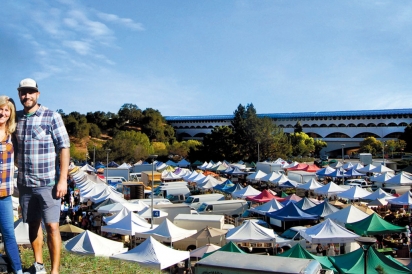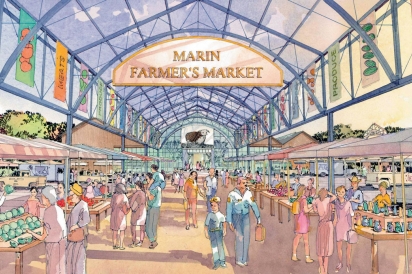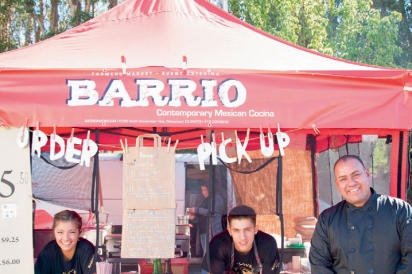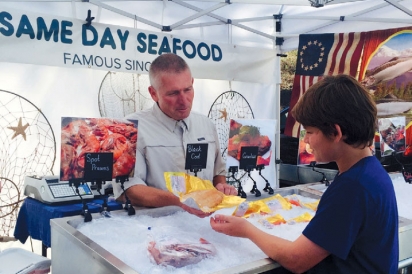A market improvement
Permanent Home Will Further Civic Center Farmers’ Market Role as a Center of Our Community
Brigitte Moran, the CEO and director of the Agricultural Institute of Marin (AIM), has a secret spot she visits on those days when her job is particularly hectic. This high perch provides her a wide-angle perspective on the Marin County Civic Center Farmers’ Market: the rows of white tents; the busy farmers, cheesemakers, ranchers and food stall operators thoughtfully arranging their bounty; shoppers coming and going, their reusable cloth bags overflowing with carrots, loaves of fresh-baked bread, homemade preserves and fat pink apples.
From this quiet place she can see mothers and fathers waiting outside the jumpy house, starry-eyed young couples holding bouquets of flowers, groups of students on educational tours talking to farmers, and crowds gathering around popular prepared-food stands. Here Moran can soak it all in, and remember why her tireless work to establish a permanent public farmers’ market hall and canopy at the Marin Civic Center matters.
“Looking at it from above it is so clear,” Moran says. “The number one reason we work for this is community. It is hard to put into words, but people know it when they are here. We gather together around our food, and it is special.”
Moran, who lived in Marin as a teen, has a strong sense of community, a memory of the county when it did not feel separated by neighborhoods. Growing up, she says, she experienced Marin as a bedroom suburb, largely working class, with a strong sense of cohesion. This has been part of what has fueled her as she works for a central permanent pavilion for the Marin County farmers’ market.
“Today we can be so isolated in our own little cliques,” she says. “But this permanent market will bring us all together in one place. We need that.”
According to a 2014 ballot initiative, Marin County voters agree with Moran that “we need that.” In fact, a whopping 81.5% of voters approved the long-term lease of a five-acre parcel just north of the Civic Center owned by the County (currently a parking lot) for the construction of the permanent farmers’ market hall and canopy.
Currently, around 10,000 people visit the Sunday and Thursday markets operated by AIM on the Civic Center site each week. (The Thursday market has been temporarily relocated to Northgate Mall due to construction at the Civic Center.) The market is host to 240 vendors from Marin and the larger Northern and Central California foodshed, all at portable temporary stands that have to be set up and taken down for each market.
When Moran took the helm at AIM 13 years ago, the farmers’ market board was made up of a group of farmers who had begun to advocate for a permanent location. “They felt vulnerable,” says Moran. “There was no security—with just 30-day notice, the County could ask the market to relocate from the Civic Center. They needed a permanent covering for bad weather, and bathrooms for their customers.”
They also had a vision for a place that would honor the tradition of agriculture in Marin County and show the world that our sustainable food producers and our environment are at the heart of the Marin County lifestyle.
“So then they hired me!” says Moran, who simultaneously directs AIM—a nonprofit organization that manages farmers’ markets in San Francisco, Hayward, Newark, Oakland and Marin County—and steers the partnership that will make the permanent market hall in Marin a reality. “Of course, we thought it would happen a lot faster,” she says, smiling.
As it turns out, the very thing that makes this project important has made it slow to come to fruition: This is public-private partnership, a give-and-take model of private and public supporters coming together to create community and private enterprise. As such, Moran and her AIM board first needed to get the Marin County Board of Supervisors to put the project on the Marin County ballot to allow voters to either endorse it, or not.
Once voters gave their resounding approval for moving forward, it was time to start fundraising, so Moran and the 15-member AIM board turned their attention to raising the $20 million needed to make the project a reality. They are off to an exciting start, Moran says, having raised sufficient money to fund pre-development costs such as site inspections and surveys, soil analysis, contracts and, most importantly, the design of the market hall itself.
“Being chosen to help design the AIM permanent farmers’ market is an honor,” says renowned architect Howard Backen, who donated a large portion of his costs for drawing up plans for the new hall and canopy. “The AIM market has a chance to be one of the most celebrated farmers’ markets in the US, and, hopefully, the world.”
Sausalito-based Backen is known for his thoughtful blend of contemporary and rustic, and, true to form, the market hall design has a modern but distinctly “ag” aesthetic. It features two large covered areas for 90 of the 240 vendor stalls, three buildings that will include permanent stalls (baker, butcher, dairy, etc.), 28 tables for day vendors, a restaurant with a demonstration kitchen, a café, offices for agricultural organizations, conference areas, a greenhouse, educational gardens and a play area for children.
As someone who knows well the sometimes-cramped quarters of farmers’ market venues and their parking lots, Moran is particularly happy with the wide aisles and “flow” of the design, and also with the direct public access to the SMART train system now under construction an easy walk from the site.
Carlos Rosas, a chef and founder with his wife, Myrna, of crowd favorite El Barrio Marin contemporary and seasonal Mexican cuisine, is already imagining the constant flow of people from all over the Bay Area and beyond.
“People will come by ferry from San Francisco; they will take the SMART train,” says Rosas. “I really cannot wait for that. And I cannot wait to be able to sell my food seven days a week.” El Barrio Marin is an example of a business that consumers currently can only patronize at the Sunday and Thursday Marin farmers’ markets. These markets have allowed the Rosases to launch their business, connecting them to a customer base that was immediately responsive to their food, and also connecting them to the farmers of the region, from whom they now source 95% of their produce.
“I am so happy,” says Rosas. “I always want to say thank you to everyone who runs this market. And working with these farmers and ranchers allowed my business to grow. Now I want to do everything I can to educate my customers about these farmers who are also at the market, about where the meat they’re eating comes from, where the produce comes from.”
“In Marin, if you’re a [food] entrepreneur and you have a dream, the market is a place where dreamers come to build their businesses,” say Moran.
When she describes the opportunities for mutual support and growth that will be provided by a permanent hall, she is thinking precisely of entrepreneurs like Rosas who, three years ago, had 40–50 customers visit his stand on a Sunday. Now he has 250–350 each day, a thriving catering business and plans to open a restaurant.
“It’s kind of the American Dream. And we get to taste it all!” Moran adds. She reminds us that it is easy to romanticize the life of a farmer or other producer, but most do not get to enjoy the classic Marin lifestyle, and instead work around the clock seven days a week just to make ends meet.
“It is a hard life!” she says. “And we have to remember that 240 businesses don’t just ‘appear’ in the parking lot every Sunday and Thursday.” Beyond working on their farms and in their kitchens to bring their products to San Rafael, vendors spend a tremendous amount of time and labor setting up and breaking down their stands every time they go to a market. A major goal in developing a permanent structure is to alleviate that burden.
Gary Root, owner of Same Day Seafood, a purveyor of wild and sustainably caught seafood, starts most days at 2am.
“We are a small company, a small team, and my plant is in South San Francisco, so I get up that early to get everything ready,” says Root. “We spend a lot of time going back and forth to the markets.” Root can imagine various ways the permanent market will reduce what he calls the “time suck” elements of running his business, and one example is sharing resources with other vendors. “For example, we use a lot of ice,” he says. “Those are the types of needs we can mitigate on a shared basis at this new venue.”
Root, who founded and sold several successful hi-tech companies before following his dream to become a fisherman and start a seafood company, is a proponent of the market for reasons beyond the logistics and efficiency of his own business.
“This place right here, Marin County, surrounded year-round by bountiful harvests, this is the perfect place to build a world class venue for food. This market could be a vibrant destination, a top-10 tourist spot that also benefits our local community.”
“This is an opportunity for us to show the whole world what is important to the people of Marin, and to celebrate who we are, and what is available in our county,” agrees Lynn Giacomini Stray. “When you go to other countries, people can name off well-known markets around the world. We want to put our stamp on that map.”
Stray, an AIM board member, is a fourth-generation dairy farmer who now, along with her three sisters, operates the family’s Point Reyes Farmstead Cheese Company. She believes that Marin has made a name for itself on the cutting edge of agriculture and artisan food production and that the permanent hall is what will allow the next generation of forward-thinking food producers to continue to respond to consumers and provide the healthiest, most sustainable and most delicious food possible.
“There is really nothing as satisfying as getting instant feedback from customers,” she says, adding that those “high-touch” opportunities— bringing both praise and suggestions for improvement—happen only at the farmers’ market.
“But, as it is, farmers’ markets are more for community outreach because they are not profitable enterprises,” says Loren Poncia of Stemple Creek Ranch, who is also a fourth-generation Marin County farmer who has sold his grass-fed beef and lamb at the Civic Center market for six years. “If we could sell our meat and stay in touch with our consumers every day, if all we had to do is show up at the permanent market with our meat, that would change everything. It would be amazing.”
Stray and Poncia are members of a generation of Marin farmers who have had to be nimble and determined to keep their families’ businesses alive, and who have evolved their practices to lead the nation in environmentally sustainable agriculture. Now they are looking to the future, and they see the market hall as a critical part of the equation.
“We want this next generation of farmers to have the security of a 40-year lease, of a foundation set in concrete,” says Stray. “We want them to be able to thrive so they can continue to respond to consumers and shifts in the food industry.”
For AIM board member Pat Kendall—a Kaiser medical group administrator and a founder of the Healthy Marin Partnership, a coalition of health, education and philanthropic organizations—the “respond to consumers” part is key to the health of our community.
“This permanent pavilion is about health,” she says. “Health care is very dependent on what we do upstream, what we eat, what we drink and how active we are. This market will be our centerpiece for maintaining and improving health.”
Studies site Marin as one of the healthiest counties in California, and, as such, Kendall believes we have a responsibility to uphold that standard and lead by example in honoring the generations of farmers who allow us to eat the way we do.
The current markets host 4,000 school children a year on educational tours, teaching future generations about food systems and personal and environmental health. Those numbers have the potential to balloon at the proposed venue, which includes classrooms and demonstration gardens and kitchens.
“Children of all ages will be able to learn and delight in how food is grown and how to eat healthier,” says Kendall. “I am crystal clear this is the right thing to do, for the right reasons, and at the right time.”
While the vision of everything the permanent market hall can be and do has become more and more clear, and support for the project has become almost unanimous across Marin County, the greatest hurdle—that $20 million it will take to build—still lies ahead. Moran just secured the first $1 million, a donation from an AIM board member, and is hoping to reach a benchmark of $5 million before she looks to foundations for matching funds.
From time to time, she says, she will take a group of potential funders up to her secret overlook to take in the beauty of our community gathering around food, and to help them imagine all that the permanent structure will provide for both our agricultural community and our citizens. She hopes all of us living in Marin can imagine and embrace this vision of the permanent market hall.
“We’re often looking for someone else to do it, but this is our community, our agriculture and our future, so we need to step up.”
To take a virtual tour of the plans for this important project, visit: Marin Public Market Hall YouTube.com/watch?v=nEGHU-ENqFc









